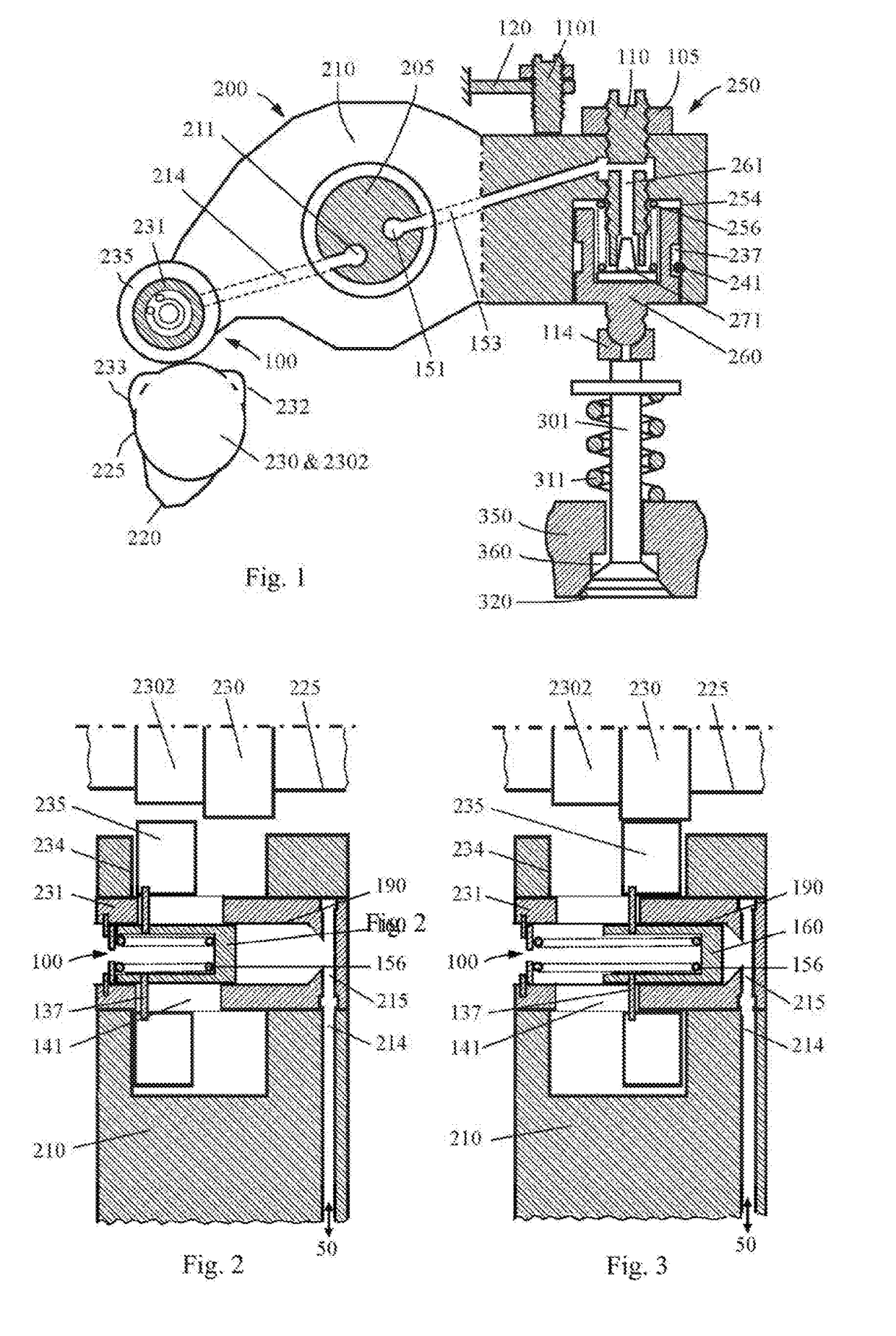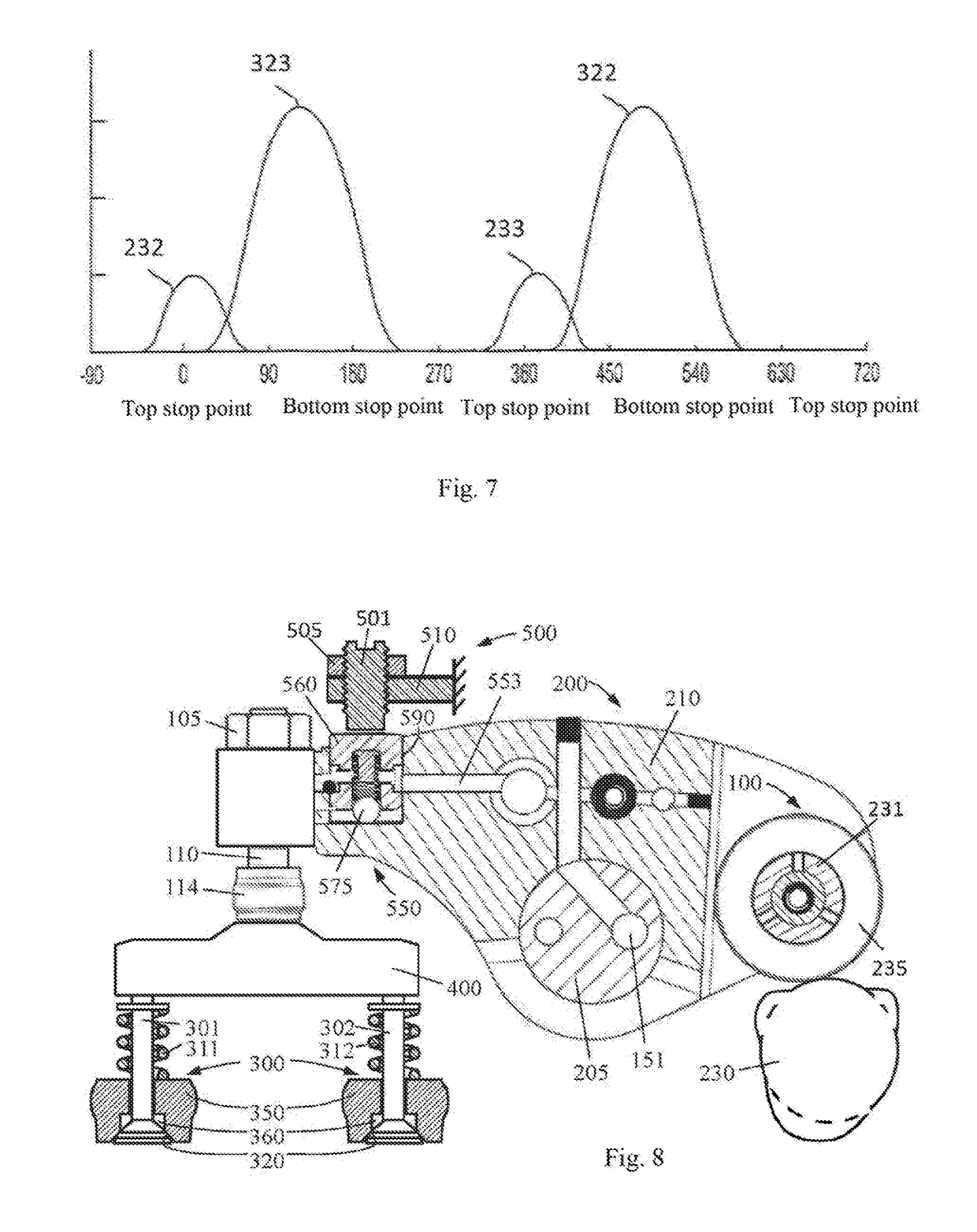Multifunctional engine brake
a multi-functional, engine technology, applied in the field of machine tools, can solve the problems of reducing or even eliminating the valve motion, reducing the speed of the valve seat, and losing all cam motion, so as to reduce the falling off, and effectively slow down and control the valve seat speed
- Summary
- Abstract
- Description
- Claims
- Application Information
AI Technical Summary
Benefits of technology
Problems solved by technology
Method used
Image
Examples
embodiment 1
[0049]FIGS. 1, 2 and 3 are used to describe embodiment 1 of the engine valve motion conversion mechanism in the present invention. FIG. 1 is an illustration (side view) of an engine valve drive device in embodiment 1. The valve actuator 200 (the description herein applies to both the intake valve actuator and the exhaust valve actuator) includes cams (such as a conventional ignition cam 230 and an engine brake cam 2302), a roller 235 and a roller shaft 231. In addition to being able to rotate on the roller shaft 231, the roller 235 can also move axially along the roller shaft 231 (FIGS. 2 and 3). This embodiment shows two different cams 230 and 2302 (for example, the conventional ignition cam 230 and the engine brake cam 2302), which have different profile curves (lift and phase), but they are located on the same camshaft, adjacent to each other and have the same or approximately the same inner base circle 225. The valve actuator 200 also includes a rocker arm (also called a roller ...
embodiment 2
[0056]FIGS. 4 and 5 are used to describe embodiment 2 of the engine valve motion conversion mechanism in the present invention. The main difference between this embodiment and the above embodiment 1 is the oil feeding mode of the axial roller drive mechanism 100. In this embodiment, a directional valve mechanism 600 and an accumulator 900 are added to the rocker arm (roller shaft housing) 210. The directional valve mechanism 600 includes a directional piston 660 and a directional spring 656. One side of the directional piston 660 in the directional piston bore 690 is acted upon by fluid (e.g., oil pressure) and the other side is acted upon by a directional spring 656. The accumulator 900 includes an oil storage piston 960 and an oil storage spring 956. One side of the oil storage piston 960 is acted upon by fluid (e.g., oil pressure) and the other side is acted upon by the oil storage spring 956, so the piston 960 can move between a non-oil storage position (FIG. 4) and a full oil s...
embodiment 3
[0059]FIGS. 8, 9 and 10 are used to describe embodiment 3 of the seating velocity control device in the present invention. FIG. 8 is an illustration (side view) of embodiment 3 of the seating velocity control device in the present invention. The rocker arm 210 is connected to the valve bridge 400 on the end close to the valve 300 through a conventional valve lash adjustment mechanism, and the valve bridge 400 acts on both engine valves 300 (301 and 302) (here, a dual valve engine is shown, but the present invention is also applicable to a single valve engine). The two valves 301 and 302 are biased to the valve seat 320 of the engine block 350 by the valve springs 311 and 312, respectively so as to prevent gas from flowing between the engine cylinder and the gas manifold 360. The conventional valve lash adjusting mechanism includes a valve lash adjusting screw 110, a lock nut 105, and an elephant foot pad 114. From the above description, it can be seen that the valve actuator 200 her...
PUM
 Login to View More
Login to View More Abstract
Description
Claims
Application Information
 Login to View More
Login to View More - R&D
- Intellectual Property
- Life Sciences
- Materials
- Tech Scout
- Unparalleled Data Quality
- Higher Quality Content
- 60% Fewer Hallucinations
Browse by: Latest US Patents, China's latest patents, Technical Efficacy Thesaurus, Application Domain, Technology Topic, Popular Technical Reports.
© 2025 PatSnap. All rights reserved.Legal|Privacy policy|Modern Slavery Act Transparency Statement|Sitemap|About US| Contact US: help@patsnap.com



